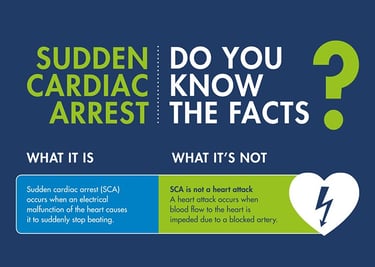October Is Sudden Cardiac Arrest Awareness Month

In 2016, more than 350,000 people in the US were victims of sudden cardiac arrest (SCA), and the overall survival rate was only 12%.1
Despite these startling statistics, SCA is often confused with another serious condition, a heart attack. Cardiac arrest differs in significant ways from a heart attack. In a heart attack, the blood supply to the heart muscle is suddenly blocked, resulting in the death of the heart muscle. Symptoms of a heart attack can vary; they may come on suddenly or start slowly and persist for hours, days, or weeks. Heart attack victims typically experience chest pain, discomfort in the back or jaw, nausea and/or vomiting, and typically remain conscious. Heart attacks are serious and can sometimes lead to SCA; however, SCA may occur independently from a heart attack and without warning signs.
Cardiac arrest can come on suddenly. The heart unexpectedly and abruptly stops beating properly when the heart’s electrical system malfunctions. This is usually caused by an abnormal heart rhythm called ventricular fibrillation (VF), in which the heart quivers and cannot effectively pump blood. The only effective treatment for VF is an electrical shock administered by an automated external defibrillator (AED) followed by high-quality cardiopulmonary resuscitation (CPR).
While the average age of heart attack victims is mid-60s, sudden cardiac arrest is unpredictable and can strike anyone, anywhere, anytime. Some risk factors include:
- Family history of cardiac arrest in a first-degree relative: two-fold increase in risk of SCA2
- Underlying coronary heart disease (CHD)3
- A personal or family history of inherited disorders that make you prone to arrhythmias (abnormal heart rhythm)3
- A personal history of arrhythmias3
- Heart attack3
- Heart failure3
- Commotio cordis—a term referring to SCA resulting from a blow to the chest
- Drug or alcohol abuse
Regardless of the cause, SCA results in death if not treated immediately. It can, however, be treated successfully with CPR, defibrillation, and advanced life support. Thus, access to AEDs is critically important to surviving SCA. For more information on SCA and the AED Plus®, please read our focus story.
1“Statistical Update.” American Heart Association Website, www.cpr.heart.org/AHAECC/CPRAndECC/General/UCM_477263_Cardiac-Arrest-Statistics.jsp. Accessed 11 Aug 2017.
2Roger VL, Go AS, Lloyd-Jones DM. Executive Summary: Heart disease and stroke statistics-2012 update: A report from the American Heart Association. Circulation. 2012:125(1):188-197.
3National Heart, Lung and Blood Institute, www.nhlbi.nih.gov.








